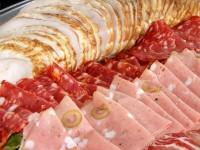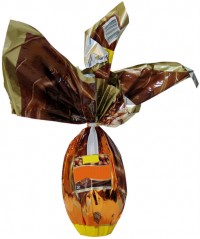Traveling in Italy during Easter can be wonderful or perilous. Before you decide, read my story. Perhaps this is a funny story. I’m not sure. Tragic might be the more appropriate description.
 The first time I spent Easter in Italy, we stayed in a beautiful villa, an ancient palazzo, in the south. I’d spent a carefree day by the seashore and casually planned an elaborate dinner for the evening. A large selection of fresh cheeses, taralli, and cured meats would serve as antipasti followed by a creative version of bruschetta, topped with roasted bell pepper, pesto, and cream cheese. For primi, we were making an herbed, mushroom risotto. Secondo was to be eggplant parmesan. This was back when I was learning how to eat like a real Italian, how to discover my second stomach and fill it.
The first time I spent Easter in Italy, we stayed in a beautiful villa, an ancient palazzo, in the south. I’d spent a carefree day by the seashore and casually planned an elaborate dinner for the evening. A large selection of fresh cheeses, taralli, and cured meats would serve as antipasti followed by a creative version of bruschetta, topped with roasted bell pepper, pesto, and cream cheese. For primi, we were making an herbed, mushroom risotto. Secondo was to be eggplant parmesan. This was back when I was learning how to eat like a real Italian, how to discover my second stomach and fill it.
We’d been cooking for a couple hours when the bombola ran out. A bombola is the gas tank that fuels a gas stove. We were only a few minutes away from having a fully cooked eggplant parm and piping hot risotto. We called our landlady to see if she could fix it, but she sadly replied, It’s Easter! It will be very difficult to find a gasman. Nobody works on Easter! … We went out for pizza.
 Easter is the most important holiday in Italy. Think of the Christmas season in the United States. Many establishments close for an entire week in order for families to spend time together. It is a time of good food, tradition, and laughter, and this is both a good and a bad thing for travelers.
Easter is the most important holiday in Italy. Think of the Christmas season in the United States. Many establishments close for an entire week in order for families to spend time together. It is a time of good food, tradition, and laughter, and this is both a good and a bad thing for travelers.
First, the Easter season is considered high season by hotels and resorts and the prices for rooms are at their peak. Likewise, because so many Italians are on the road visiting relatives, many hotels become full, and it’s important to book your accommodations well in advance. Trains also feel the pressure, which comes as a result of suspending several lines for the holiday and the elevated number of passengers. If you plan on taking a train, book in advance and make sure to reserve seats if possible. This is one time of year when failing to reserve a seat might result in standing in the train corridor.
The most important thing to remember is to anticipate any needs you might have during the Easter holiday. If you think you might need a set of batteries for your camera or another package of razors, it’s paramount that you buy them in advance. Nothing will be open except restaurants and gelaterias.
 Once these basic needs are satisfied, Easter in Italy is a time of celebration. Giant, brilliantly wrapped chocolate eggs (sometimes three feet tall or taller), lambs made of marzipan, and dessert-like breads such as Pannetone are everywhere. Traditional meals served include every Italian dish imaginable, but there will certainly be a lamb course. The lamb is often prepared stuffed with basil and roasted. Artichokes are also popular because they are in season. If you are in Rome, don’t miss the carciofi alla giudia, or Jewish-style artichokes, which are deep-fried. For desert, the La Pastiera of Naples and the Pardulas of Sardinia are favorites. La Pastiera are wheat-berry cakes made with ricotta, dried fruit, and orange-blossom water. Pardulas are pastries made with citrus and fresh cheese.
Once these basic needs are satisfied, Easter in Italy is a time of celebration. Giant, brilliantly wrapped chocolate eggs (sometimes three feet tall or taller), lambs made of marzipan, and dessert-like breads such as Pannetone are everywhere. Traditional meals served include every Italian dish imaginable, but there will certainly be a lamb course. The lamb is often prepared stuffed with basil and roasted. Artichokes are also popular because they are in season. If you are in Rome, don’t miss the carciofi alla giudia, or Jewish-style artichokes, which are deep-fried. For desert, the La Pastiera of Naples and the Pardulas of Sardinia are favorites. La Pastiera are wheat-berry cakes made with ricotta, dried fruit, and orange-blossom water. Pardulas are pastries made with citrus and fresh cheese.
As for my first Easter in Italy, I ate out all week. The meals were delicious and the atmosphere was jovial, but I didn’t get a new bombola until the parties were over.


Comments